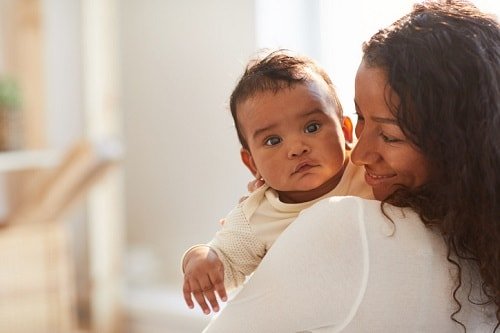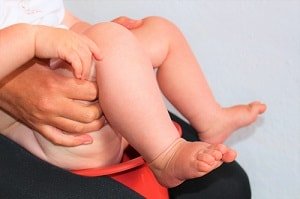Infant toilet training: The scientific evidence
© 2022 Gwen Dewar, Ph.D., all rights reserved
 opens IMAGE file
opens IMAGE file
Widely practiced in traditional cultures, infant toilet training is becoming more than popular in Western countries. But what are the pros and cons of early preparation? How do you actually do it? And what does science tell united states of america almost the evolution of bladder control?
If you grew up in a culture that uses diapers, infant toilet training might seem unconventional and exotic. But in traditional societies throughout the globe — in Asia, Africa, Eastern Europe, Latin America, and the Chill — infant preparation is the norm.
When babies need to urinate or defecate, their parents concord them, bare-bottomed, over a preferred target (like a waste receptacle, or an outdoor latrine). The parents indicate the babies to go along, and the babies respond (Boucke 2003; Duong et al 2013a; Sonna 2006; deVries and deVries 1977).
How do parents know when their babies need to eliminate?
In that location isn't any magic here. The parents pay close attention. They larn to read their babies' cues. And eventually, subsequently multiple trials, babies larn to agree back until their parents give them the point — normally a special vocalization, similar "sheee-sheee," or "shuuuus" (Bouke 2003; deVries and deVries 1977).
In other words, it's all about communication — what some folks telephone call "elimination communication." And it's condign more pop in Western countries, like the United States (Bough and She 2017).
Simply are these babies truly "toilet trained"?
That depends on what you lot mean. Young babies can't walk, wipe, or apparel themselves. So they aren't "trained" in the sense of being capable of taking independent trips to the toilet. But toilet sessions become more coordinated, organized, predictable. And families tin can go "diaper free."
Is this a goal worth pursuing? When should parents begin baby toilet grooming? What procedure(due south) should they follow? And what does enquiry tell the states about the development of bladder and bowel control? Is early training a skillful choice for your infant?
Here are the details to assist you lot make up one's mind. I cover the potential benefits of infant toilet training, and outline the general procedure associated with elimination communication. In addition, I provide a link to an culling method of baby potty training, and review some of the developmental (and cultural) factors that can make baby training hard.
What are the benefits of infant toilet grooming?
Babe toilet training depends on establishing close communication about the infant'due south frequent needs to eliminate. Information technology's fourth dimension-consuming, merely potentially rewarding in the same way that advice about feedings can exist rewarding.
In improver, babe toilet preparation makes it possible for families to reduce — or eliminate — their usage of diapers. This means
- saving coin on diapers and diaper paraphernalia;
- generating fewer non-biodegradable, dispensable diapers; and
- using less energy to wash and dry cloth diapers.
It likewise means avoiding diaper rash and diaper-related infections.
And in the long-term? Parents who train early may avert certain pitfalls, at to the lowest degree when compared with parents who delay training until children are over the age of two or three.
When kids have spent years wearing diapers, parents often face these difficulties:
- Older children take learned to ignore their ain torso signals and must re-learn them.
- Older children are used to wearing soiled diapers and may resist alter.
- Older children are more likely to test your say-so when you ask them to comply with potty training.
Finally, there'due south some evidence that infant toilet training helps babies learn how to completely empty their bladders when they urinate (Duong et al 2013b). This is potentially important, because remainder urine in the float can lead to urinary tract infections.
And so when should a infant kickoff toilet preparation?
Information technology isn't really a affair of "should." Some parents starting time right later birth (Duong et al 2013a; Boucke 2003). Others expect until 3-6 months (Schaefer and DiGeronimo 1997; Smeets et al 1985).
What'south the procedure? How does infant toilet training work?
Typically , parents follow these steps:
i. Get familiar your baby's emptying patterns.

How does your baby acquit just before he or she eliminates? Some babies may squirm or shudder simply earlier they have to go. Others might change their breathing patterns, or begin crying, or adopt a particular facial expression.
In add-on, pay attending to timing. Babies may tend to urinate shortly after a feeding. They may void just before — or immediately after — sleeping. Some babies may urinate pretty regularly, once an hour or so.
Watch for these patterns, and learn to anticipate when your baby is about to go.
2. When your babe shows signs of needing to eliminate, provide the opportunity: Hold your baby's blank bottom over an appropriate receptacle.

This doesn't have to be a toilet. For immature babies, some parents use plastic tubs or bowls (Boucke 2003; Sonna 2006). In traditional cultures, babies often urinate outdoors, on the footing.
3. Teach your baby to acquaintance the human activity of eliminating with a signal of your choosing.
In many parts of the globe, parents make a characteristic sound or gesture while the infant voids. Babies learn to associate the sound with the action.
4. Once your infant has learned the indicate, use information technology to encourage your baby to eliminate on cue.
Now you accept some influence over the timing of toileting. For example, before yous have your baby on an outing, you can ask your baby to void. Provide the opportunity, and give your baby the point. Similarly, y'all tin invite your baby to eliminate afterwards meals, or just before bedtime.
Are there any alternatives to this method?

Yeah. If your baby has reached the milestone of being able to sit down up independently — without beingness held in place, or propped upwardly by objects — you tin can try a different technique that makes us of an infant potty chair.
This approach has been investigated by Western researchers (Smeets et al 1985), and tested on a small number of babies — with success. If you're interested, be sure to check out my Parenting Scientific discipline guide to this alternative opens in a new windowinfant toilet preparation method,
How long does it take before a baby is "trained"?
In cultures that practice traditional infant training, infants complete grooming between half-dozen-12 months (Duong et al 2013a; Boucke 2003; deVries and deVries 1977).
And in a study testing the alternative (potty chair) method, the participating infants completed training before they were 12 months old (Smeets et al 1985).
Simply hang on…how is any of this possible? Aren't babies supposed to be incapable of bladder and bowel control?
Granted, babies aren't miniature adults. They tin can't control elimination to the extent that we tin. For example, in ane report, researchers found that only 20% of children attained "complete" bladder and bowel command past the historic period of 2 years (Largo et al 1978).
But infant potty training does non require "consummate" control. For grooming to be successful, babies need only follow some predictable patterns, and be capable of partial control.
These requirements are met rather hands for bowel movements. After the newborn period, bowel movements are relatively infrequent, and the warning signs of an impending bowel movement are pretty easy to read. Parents and babies take time to react.
And for urination?
Granted, bladder training is more difficult. Infants accept small float capacities and process big volumes of liquid. They urinate frequently, and it can be hard to tell when they are most to pee.
In addition, some young infants may accept trouble analogous their muscles.
They can contract the bladder wall (which increases pressure within the bladder) and they can relax the urinary sphincter (which opens the urethra and permits urine to menstruation outside the trunk). But they may take trouble doing both at the same fourth dimension. Every bit a result, they may not completely empty their bladders with every voiding (Yeung et al 1995; Sillén et al 1996; Bachelard 1998).
Merely this doesn't mean that babies urinate in a random, haphazard mode. On the reverse.
As noted above, babies are more than likely to urinate at certain times during the day.
They are more likely to urinate after feedings. They are also more than likely to pee when they are fully awake, or transitioning to waking. Babies tend not to urinate when they are in "serenity sleep" — an baby sleep stage analogous to our adult phase of "deep" sleep (Yeung et al 1995; Wen and Tong 1998).
And just every bit importantly, babe bladders aren't hopelessly weak or erratic.
The muscles of the bladder wall are usually stable, contracting merely around the time of urination (Yeung et al 1995; Wen and Tong 1998). And when researchers have tried to provoke healthy newborns to urinate by manually pressing their bladders, it didn't work. The bladders didn't leak (Gladh et al 2000).
So research refutes the notion that baby bladders are totally uninhibited (Sillén 2001; Yeung et al 1995).
Babe urination is not just an automatic reflex (Sillén 2001; Yeung et al 1995). And that's why infant potty training — relative dryness achieved through parental supervision — is possible.
What about the burden on parents? Isn't babe toilet training time-consuming and messy?
The short answer is: Yes.
Infant toilet grooming depends on the close proximity and vigilance of the caregiver. It is unquestionably time-consuming.
At nascence, the average infant pees approximately 20 times a solar day (Geoller et al 1981). The frequency decreases over time, so some authors recommend that parents delay babe preparation until the tertiary month (Schaefer and diGeronimo 1997).
Nonetheless, float capacities vary, and some infants void very frequently throughout the toddler menstruation. Other infants dribble soft stools throughout the day. Parents must weigh these factors accordingly.
Next, consider the mess.
Although infant waste is less smelly than toddler waste (Sonna 2006), it's however messy. Some advocates argue that infant toilet training is less messy than diapering, because diapering forces the parent to clean up every fourth dimension a babe poops (DiaperFreeBaby.org 2006).
But I retrieve this misses the point that concerns most Westerners, which is that diaper-costless babies may soil furniture, rugs, and other items that are rather difficult to clean.
Parents can minimize the mess by keeping babies abroad from such items.
Alternatively, they can prefer the potty chair-based method of infant toilet preparation.
Or merely continue their babies in diapers during the early phases of training.
Yet millions of people do babe toilet training without using diapers at all. How do they exercise it?

Toddler in Shanghai wearing open-crotch pants. Image by Kolumbusjogger.
I call back it likely comes downwardly to a difference in mental attitude and social support.
From Kenya (deVries and deVries 1977) to Bali (Diener 2000), parents don't consider the occasional accident a big deal. Nobody minds much if a trivial baby urine gets on their dress or flooring. Accidents happen. Cleaning upwards is part of parenting.
In addition, traditional, "diaper-free" societies are often more tolerant of small children eliminating in public. Local customs make it easier for parents to train.
For example, in China, young children vesture pants with an open seam in the back and so kids can squat and go when the demand arises.
And among the Ifaluk of Oceania, toddlers can pee but almost anywhere as long equally it's outside (Le 2000).
Attitudes and customs in the West are less supportive of infant potty training. This needn't deter motivated Western parents. But it's obvious that babe training isn't for everyone.
Whether you plan to train early on or tardily, you lot volition need to exercise patience, good sense of humour, and gentleness. There will be accidents and setbacks. No ane should effort baby toilet preparation without a articulate understanding of the work involved.
Lessons for the West?
Despite the difficulties, some parents are proving that it's possible to practice infant toilet grooming in the West. Books, websites, and online communities offer communication and psychological support. Savvy parents swap tips near where to buy Chinese-way preparation pants or how to survive car travel.
For these parents, the advantages of infant toilet training — no diapers, no rashes — make the extra work worthwhile.
And for parents who don't plan to train their infants, "elimination communication" is yet instructive.
It reminds u.s. that diapers are not a necessary or natural part of infancy. Nor is diaper rash or diaper dependency. Babies who never wear diapers won't have to exist cajoled back out of them when they are older.
Postscript: Unwarranted claims
I've seen a few questionable claims fabricated about infant toilet grooming that merit discussion. Then I want to address them here.
First, I can find no prove that infant toilet training makes people into improve, more sensitive parents.
Nor have I run across any studies suggesting that potty training of any kind–infant or otherwise–improves the parent-child relationship.
Second, I've not found whatever studies suggesting that infant toilet preparation — when carried out in the manner noted in a higher place — has any meaningful, long-term, developmental impact on a child's life.
Equally noted to a higher place, at that place's evidence that it helps babies develop salubrious voiding patterns at an before age (Duong et al 2013b). And information technology's logical to assume that trained infants would be less at gamble for developing rashes and diaper-related infections (Bender and She 2017).
Simply there'south no reason to remember that babe toilet preparation will change your child'south psychology, for ameliorate or for worse. You tin can read more about it in this Parenting Science article almost the timing of toilet training.
Finally, it bears repeating that "infant toilet grooming" is a potentially misleading term.
Babies don't get trained in the manner that older children practise. Instead, parents learn to anticipate when their babies are ready to void and babies learn that a specific sound ways "go alee and urinate at present."
If not during infancy, when?
When it comes to timing the onset of toilet training, parents accept many options. What does inquiry tell united states of america well-nigh delaying training until your kid is 12 months old? 18 months former? 24 months old? Or even older? My Parenting Science article about opens in a new windowthe timing of toilet training volition help y'all compare the pros and cons associated with different ages.
Books about infant toilet preparation
Laurie Boucke provides a detailed business relationship of babe toilet training in her how-to book, Infant Potty Training: A gentle and primeval method adapted to modern living (2002; White-Boucke publishing).
Her book includes photos and sketches illustrating techniques, likewise every bit a section on cantankerous-cultural studies. An abridged version of this volume is available under the championship Baby potty training: With and without diapers—the natural way (2003; White-Boucke publishing).
References: The science of infant toilet grooming
Bachelard K, Sillen U, Hansson Southward, Hermansson K, Jodal U, and Jacobsson B. 1998. Urodynamic pattern in infants with urinary tract infection. Periodical of Urology, 160: 522-6.
Bender JM and She RC. 2017. Emptying Advice: Diaper-Gratuitous in America. Pediatrics. 140(i).
deVries MW and deVries MR. 1977. Cultural relativity of toilet training readiness: A perspective from East Africa. Pediatrics, sixty: 170-177.
Diener M. 2000. "Souvenir from the gods: A Balinese guide to early child rearing," in A world of babies: Imagined childcare guides for seven societies (J. DeLoache and A. Gottlieb, eds.) New York: Cambridge University Press, pp. 199-231.
Duong TH, Jansson UB, Hellström AL. 2013a. Vietnamese mothers' experiences with potty training procedure for children from birth to 2 years of age. J Pediatr Urol. ix(6 Pt A):808-14.
Duong TH, Jansson UB, Holmdahl K, Sillén U, Hellström AL. 2013b. Urinary bladder control during the offset three years of life in salubrious children in Vietnam–a comparing written report with Swedish children. J Pediatr Urol. 9(6 Pt A):700-vi.
Geollner MH, Ziegler EE, and Fomon SJ. 1981. Urination during the commencement three years of life. Nephron., 28: 174-178.
Gladh Thou, Persson D Mattsson S and Lindstrom S. 2000. Voiding blueprint in healthy newborns. Neurourology and urodynamics, xix: 177-184.
Largo RH, Gianciaruso M, and Prader A. 1978. Evolution of abdominal and float control from nativity until the 18th year of historic period. Longitudinal study. Schweiz Med Wochenschr, 108: 155-160.
Largo RH and Stutzle 1977. Longitudinal study of bowel and bladder control by mean solar day and at night in the first six years of life. I: Epidemiology and interrelations between bowel and float command. Dev Med Child Neurol, xix: 598-606.
Le H-N. 2000. "Never leave your little one alone: Raising an Ifaluk child," in A globe of babies: Imagined childcare guides for seven societies (J. DeLoache and A. Gottlieb, eds.) New York: Cambridge Academy Press, pp. 199-231.
Schaefer CE and diGeromino TF 1997. Toilet training without tears. New York: Signet.
Sillén U. 2001. Bladder office in healthy neonates and its development during infancy. Periodical of Urology, 166(6): 2376-81.
Sonna L. 2005. Early on-start potty grooming. New York: McGraw-Hill.
Smeets PM, Lancioni GE, Ball, TS, and Oliva DS. 1985. Shaping self-initiated toileting in infants. Journal of applied behavior analysis, 18: 303-308.
Wen JG and Tong EC. 1998. Cystometry in infants and children with no apparent voiding symptoms. British Journal of Urology, 81: 468-473.
Yeung, CK, Godley ML, Ho, CK, Ransley PG, Duffy PG, Chen CN, Li AK. 1995. Some new insights into bladder part in infancy. British Periodical of Urology, 76:235-40.
Content of "Baby toilet training" last modified 9/2020
title paradigm by SeventyFour / istock
image of parent holding baby over a plastic tub for urination by shutterstock
Prototype of toddler wearing traditional, open-crotch pants by opens in a new windowKolumbusjogger / wikimedia commons
Portions of this text appeared in a previous version of this article, written by the same writer.
Source: https://parentingscience.com/infant-toilet-training/
0 Response to "Infant toilet training: The scientific evidence"
Postar um comentário